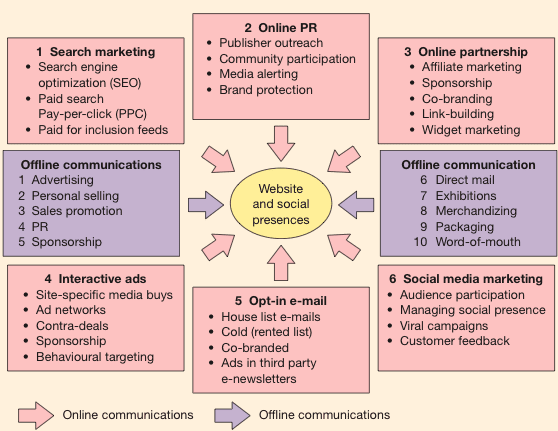Chaffey (2011) describes how social media is a fundamental part of digital marketing in his description of modern marketing channels. The nature of social media makes it one of the most important modern marketing channels for a plethora of businesses. Not only are a whole generation now glued to their phones and laptops, but with over 2 billion users on Facebook (Constine, 2017) out of the worlds 7.6 billion residents (United Nations, 2017), it is fast becoming a marketplace in its own right. As a result, it has become more and more imperative to audit these channels, to examine the ways in which social media can be used effectively.
Chaffeys Digital Marketing Channels

The first and possibly most important way to audit a social media channel is to regularly check it. It sounds simple, but the beauty of social media is that it is all in real time and constantly changing with your audience. Lee (2014) also describes how consistently maintaining social media presence is like having a “full-time job”, so much so, it must remain a continuous area of examination and inspection especially in the business environment.
With the combination of regular checks, one could use a series of templates to identify key performance indicators. This model was developed by Quesenberry (2015) and was developed by building off ideas from a journalistic framework, which outlines “Who”, “Where”, “What”, “When” and “Why” in communication channels (an example of which is shown below).

In this case, even though it has been simplified one can see that the focus is on the companies own posting, the consumers posting tendencies and finally their competitor’s online habits. As well as, a challenge and opportunity rating has been incorporated to clearly define areas that need attention. This can be a useful tool in trying to understand areas of improvement for any business with a social media presence.
Once the audit template has been completed a meticulous study of said social media platforms must be undertaken. With this next area of study, one will focus on the complete branding of a page i.e. a Twitter profile or a Facebook page. The general aim of social media marketing is to promote a brand, to do this there must be a high level of consistency in marketing material and content (Bigcommerce, 2017). Marketing material and content in this sense includes promotional photos, videos, links etc.. that are posted by that account. The music industry is one of the clearest examples of this – The Red Hot Chili Peppers Facebook page has masses of consistent branding as shown below. In this instance they are promoting a new selection of download offers for black Friday sales – one can easily see the consistent graphics and branding throughout their page.
Finally, identify where and what kind of post are getting the best reaction from an intended audience. If for example, your Instagram page gets constantly more likes on a photo compared to the same one posted on Facebook, but far fewer views on videos. One can change the strategy for posting to accommodate the consumer preference, this will ensure that posts in the future will reach the intended audience in the most effective manner. Many companies will look for new intuitive ways to share content instead of through text, these can include video, pictures, infographics, memes etc… as they tend to be more engaging. This strategy is no different for multi-national corporations who use social media. A company called Sprout Social offers this analytical service with a membership fee, but this can be replicated through diligent site analysis. As a result, an analysis like this will give you an insight into the kind of people viewing the page their posting habits.
So to recap; check social media regularly, create and use an audit template, focus on branding and measure reactions and see if any strategies have been created. In reality, it can seem very daunting to be focusing on these all the same time. Setting goals and breaking down tasks is the easiest way to tackle a social media audit. Remember it is a continuous process! Happy Auditing!
tl189 – Brighton University
Refences
Bigcommerce. 2017 ” Whats is a social media audit? Optimize your social media for ecommerce success” [Access Date: 27th Nov 2017] Weblink: https://www.bigcommerce.co.uk/ecommerce-answers/what-is-a-social-media-audit-how-to-do-it/
Constine, Josh. 2017 “Facebook now has 2 billion users… and responsibility” [Access Date: 29th Nov 2017] Tech Crunch. Weblink: https://esa.un.org/unpd/wpp/Download/Standard/Population/
Chaffey, David. 2011 “Digital Marketing Channels” Smart Site [Access Date: 29th Nov 2017] Weblink: https://www.smartinsights.com/reach/attachment/digital-marketing-channels/
Lee , Kevin. 2017 “15 Minute Social Media Audit Everyone can do” Buffer Blogs [Access Date: 29th Nov 2017] Weblink: https://blog.bufferapp.com/social-media-audit
Quesenberry, Kieth A. 2015 ” Conducting a social media audit” Harvard Business Review. [Access Date: 27th Nov 2017] Weblink: https://hbr.org/2015/11/conducting-a-social-media-audit
Sprout Social 2015 “Social Media Audit” [Access Date: 29th Nov 2017] Weblink: https://sproutsocial.com/insights/social-media-audit/
The United Nations, 2017 “Total Population, Both Sexes” [Access Date: 29th Nov 2017] Weblink: https://esa.un.org/unpd/wpp/Download/Standard/Population/

Wonderful Post! I am very delighted to know how to do a social media marketing audit. I hope this article will be helpful for digital marketing students. Actually, I am a student of History. Luckily I have also found this resource with many essay examples on different topics, you can click to read more which can be useful for students to make their own academic paper. Anyway, I really appreciated the author for sharing this valuable advice for marketing students.